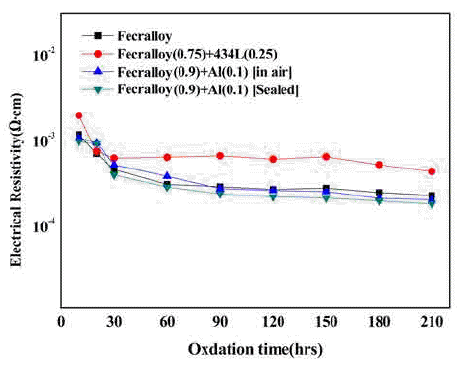Search
- Page Path
- HOME > Search
- [Korean]
- A Study on the Development of Compactability and Electrical Resistivity for P/M Fecralloy
- Jin-Woo Parka, Byung-Hyun Ko, Woo-Young Jung, Dong-Kyu Park, In-Shup Ahn
- J Korean Powder Metall Inst. 2016;23(6):426-431. Published online December 1, 2016
- DOI: https://doi.org/10.4150/KPMI.2016.23.6.426

- 484 View
- 1 Download
-
 Abstract
Abstract
 PDF
PDF The Fe-Cr-Al alloy system shows an excellent heat resistance because of the formation of an Al2O3 film on the metal surface in an oxidizing atmosphere at high temperatures up to 1400°C. The Fecralloy needs an additive that can act as a binder because of its bad compactability. In this study, the green compacts of STS434L and Al powder added to Fecralloy are oxidized at 950°C for up to 210 h. Fecralloy and Al is mixed by two types of ball milling. One is vented to air and the other was performed in a sealed jar. In the case of Al addition, there are no significant changes in the electrical resistance. Before the oxidation test, Al oxides are present in the Fecralloy surface, as determined from the energy dispersive spectroscopy results. The addition of Al improves the compactability because of an increased density, and the addition of STS434L increases the electrical resistivity by forming a composite oxide.
- [Korean]
- Mechanical Properties of Fe-P-(Mo,Mn) Sintered Alloy Related with Si Contents
- Woo-Young Jung, Dong-Kyu Park, Byung-Hyun Ko, Jin-Woo Park, In-Shup Ahn
- J Korean Powder Metall Inst. 2016;23(5):397-401. Published online October 1, 2016
- DOI: https://doi.org/10.4150/KPMI.2016.23.5.397

- 672 View
- 3 Download
- 2 Citations
-
 Abstract
Abstract
 PDF
PDF A lean alloy is defined as a low alloy steel with a minimum amount of the alloying element that maintains the characteristics of the sintered alloy. It is well known that the addition of elements such as Cr, P, Si, or Mn improves the mechanical characteristics of the alloy, but decreases the sinterability. The mother alloy is used to avoid an oxidation reaction with the alloying elements of Cr, P, Si or Mn. The purpose of this study is to determine the change in the mechanical properties of Fe-P-Mo and Fe-P-Mn alloys as a result of the addition of Si. In this article, the Fe-P-Mo and Fe-P-Mn alloys to which Si is added are compacted at 7.0 g/cm3 and then sintered in H2-N2 at 1120°C. The P around the macropores and large grains reduces due to the formation of SiO2 as the Si content increases. This is caused by the increase in strength owing to reducing intergranular fracture by suppressing the reaction with oxygen.
-
Citations
Citations to this article as recorded by- The Effects of Si or Sn on the Sintered Properties of Fe-(Mo,Mn)-P Lean alloy
Woo-Young Jung, Jin-Uk Ok, Dong-Kyu Park, In-Shup Ahn
Journal of Korean Powder Metallurgy Institute.2018; 25(4): 302. CrossRef - Sintering behavior of Fe-(Mo-Mn-P)-xSi alloys according to the Green Density
Woo-Young Jung, Jin-Uk Ok, Dong-Kyu Park, In-Shup Ahn
Journal of Korean Powder Metallurgy Institute.2017; 24(5): 400. CrossRef
- The Effects of Si or Sn on the Sintered Properties of Fe-(Mo,Mn)-P Lean alloy
- [Korean]
- The Effect of Oxide Compound on Electrical Resistivity and Oxidation Stability in High-temperature for Ferritic P/M Stainless Steel
- Jin-Woo Park, Byung-Hyun Ko, Woo-young Jung, Dong-Kyu Park, In-Shup Ahn
- J Korean Powder Metall Inst. 2016;23(3):240-246. Published online June 1, 2016
- DOI: https://doi.org/10.4150/KPMI.2016.23.3.240

- 493 View
- 1 Download
-
 Abstract
Abstract
 PDF
PDF In order to improve the high-temperature oxidation stability, sintered 434L stainless steel is studied, focusing on the effect of the addition of metallic oxides to form stable oxide films on the inner particle surface. The green compacts of Fecralloy powder or amorphous silica are added on STS434L and oxidized at 950°C up to 210 h. The weight change ratio of 434L with amorphous silica is higher than that of 434L mixed with Fecralloy, and the weight increase follows a parabolic law, which implies that the oxide film grows according to oxide diffusion through the densely formed oxide film. In the case of 434L mixed with Fecralloy, the elements in the matrix diffuse through the grain boundaries and form Al2O3 and Fe-Cr oxides. Stable high temperature corrosion resistance and electrical resistivity are obtained for STS434L mixed with Fecralloy.
TOP
 KPMI
KPMI


 First
First Prev
Prev


